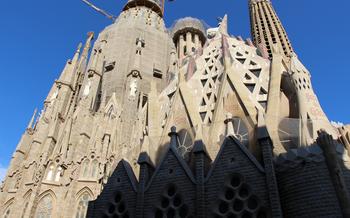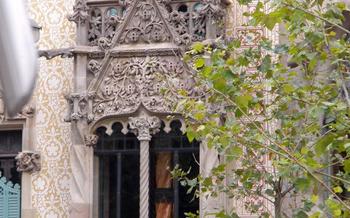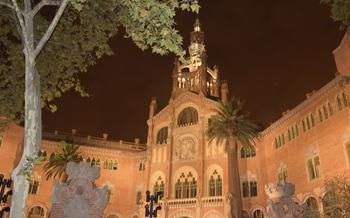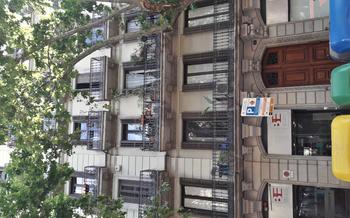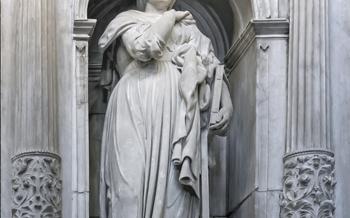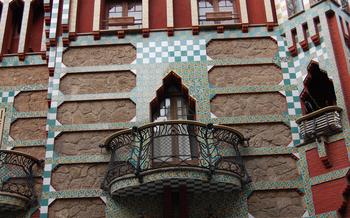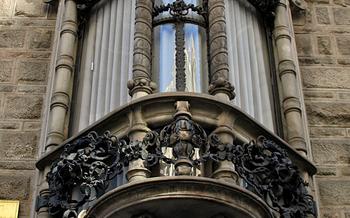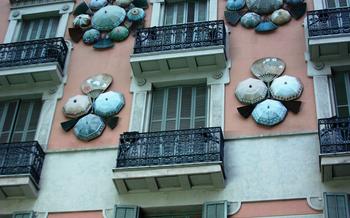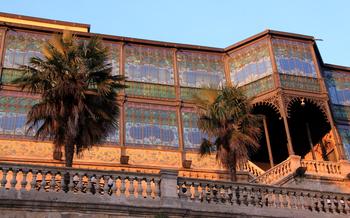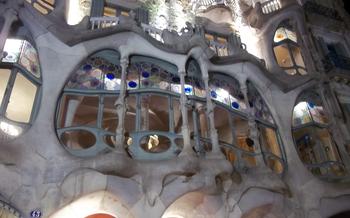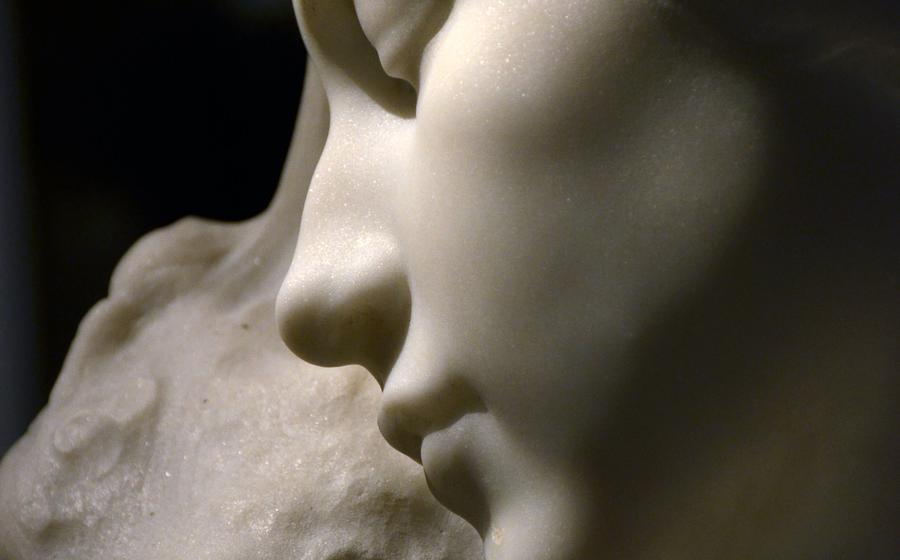
Museu del Modernisme Català
- Location and Getting There
- Hours of Operation and Admission
- Architectural Highlights
- Guided Tours and Workshops
- Photography and Videography
- Nearby Attractions
- Suggested Itineraries
- Insider Tip: Beyond the Museum Walls
Location and Getting There
The Museu del Modernisme Català is conveniently located in the heart of Barcelona, at the intersection of Carrer de Balmes and Carrer de Diagonal, in the Eixample district. This central location makes it easily accessible by public transportation, with several metro stations within walking distance. The closest metro stop is Diagonal, served by lines L3 (green) and L5 (blue). From the station, it is just a short stroll along Carrer de Balmes to reach the museum.
For those arriving by car, there are several parking options nearby. The closest parking garage is located on Carrer de Muntaner, just a few minutes' walk from the museum. Additionally, there are several street parking options in the surrounding area.
The museum is surrounded by notable landmarks and points of interest. Just across the street is the iconic Casa de les Punxes, a striking example of Catalan Modernisme architecture. Other nearby attractions include the Sagrada Família, Park Güell, and the Museu Nacional d'Art de Catalunya, all within easy walking distance or a short metro ride away.
Hours of Operation and Admission
The Museu del Modernisme Català welcomes visitors on a flexible schedule, catering to diverse preferences. During the week, from Tuesday to Friday, the museum opens its doors from 10 am to 7 pm, allowing ample time to explore its collection. On weekends, the hours are adjusted to accommodate a leisurely visit, with the museum remaining open from 10 am to 3 pm.
While general admission tickets provide access to the museum's permanent and temporary exhibitions, specific groups may be eligible for discounted rates. Students and individuals over 65 years of age can take advantage of reduced ticket prices. Families with children can also enjoy a discounted family ticket, offering a budget-friendly way to engage the entire family in the world of Modernisme.
Additionally, the museum offers free admission on certain days and hours. Every Sunday from 3 pm onwards, visitors can explore the museum's treasures without any admission fee. This initiative aims to encourage accessibility and promote engagement with the cultural heritage of Barcelona. Whether you're a local resident or a traveler on a budget, the Museu del Modernisme Català strives to create a welcoming environment for all.
Architectural Highlights
The distinctive features of Modernisme architecture are its intricate ornamentation, vibrant colors, and the use of natural forms. This style sought to break away from traditional architectural norms and embrace a more modern and organic aesthetic.
Notable architectural elements to look for in the museum's collection include stained glass windows, mosaic tiles, wrought-iron balconies, and elaborate facades. These elements combine to create a unique and visually stunning display of Modernisme architecture.
Some iconic buildings in Barcelona that showcase Modernisme include the Sagrada Familia, Casa Batlló, and Park Güell. These landmarks are must-sees for any visitor to Barcelona and offer a glimpse into the grandeur and creativity of this architectural style.
Guided Tours and Workshops
The Museu del Modernisme Català offers guided tours in various languages, including English, Spanish, and Catalan, providing visitors with in-depth insights into the history, architecture, and significance of the Modernisme movement. These tours are led by knowledgeable guides who share anecdotes and stories about the artists, their inspirations, and the social and cultural context of the period.
The museum also organizes educational workshops and programs for visitors of all ages. These workshops are a great way to engage with the Modernisme movement in a hands-on and interactive manner. Participants can learn about the techniques and materials used by Modernisme artists and create their own unique pieces inspired by the movement.
To book a guided tour or inquire about workshop availability, visitors can contact the museum's information desk or check the museum's website for more details and schedules. These tours and workshops offer an enriching experience, allowing visitors to delve deeper into the world of Modernisme and gain a greater appreciation for its artistic and historical significance.
Photography and Videography
The Museu del Modernisme Català encourages visitors to capture and share their experiences through photography and videography. Taking photos and videos for personal use is generally permitted throughout the museum, provided that flash photography and tripods are not used. This policy allows visitors to document their visit and share their appreciation for Modernisme with others. However, it is important to respect the privacy of other visitors and the integrity of the exhibits. Commercial photography and videography are only allowed with prior authorization from the museum. This ensures that the museum's collection is protected and that professional photographers do not disrupt the visitor experience. By following these guidelines, visitors can enjoy the museum's treasures while also preserving them for future generations.
Nearby Attractions
After immersing yourself in the world of Modernisme at the Museu del Modernisme Català, you can easily extend your exploration to other nearby attractions. Just a short walk away, you'll find the stunning Palau de la Música Catalana, a UNESCO World Heritage Site renowned for its intricate architecture and vibrant stained-glass windows. Continue your architectural journey by visiting the Casa Batlló and Casa Milà, two of Gaudí's most iconic creations, located within walking distance.
For a change of pace, head to the Parc de la Ciutadella, a sprawling green oasis in the heart of the city. This beautiful park offers a tranquil escape from the urban hustle, with its lush gardens, serene fountains, and the iconic Arc de Triomf. Take a leisurely stroll, rent a rowboat on the lake, or visit the Barcelona Zoo, located within the park.
If you're an art enthusiast, the Museu Picasso, dedicated to the works of the legendary Spanish artist Pablo Picasso, is a must-visit. With its extensive collection of paintings, sculptures, and ceramics, the museum offers a comprehensive insight into Picasso's artistic journey.
To make the most of your time in this vibrant city, consider exploring the surrounding neighborhood, the Eixample district. Known for its elegant architecture, wide boulevards, and lively atmosphere, the Eixample is a great place to soak in the essence of Barcelona. Stroll along the Passeig de Gràcia, lined with designer boutiques and charming cafes, and admire the many Modernisme buildings that grace the streets.
Suggested Itineraries
Tailoring your visit to the Museu del Modernisme Català depends on your interests and available time. If you're short on time, focus on the museum's highlights, such as the collection of furniture, ceramics, and decorative arts. Allocate about an hour to explore the permanent collection and another 30 minutes to view any temporary exhibitions.
For a more in-depth experience, consider joining a guided tour, which usually lasts around 5 hours. Guided tours provide valuable insights into the history of Modernisme and the significance of the museum's collection. They're available in several languages, including English, Spanish, and Catalan.
If you have a particular interest in Modernisme architecture, allocate more time to explore the museum's collection and study the architectural elements on display. You could also combine your visit with a walking tour of Barcelona's Modernisme landmarks, such as the Sagrada Familia, Casa Batlló, and Park Güell.
To make the most of your visit, plan your itinerary in advance and arrive early to avoid crowds. Allow ample time to wander through the museum's galleries and take in the beauty of the exhibits. With a little planning, you can create a personalized itinerary that caters to your interests and ensures a memorable experience at the Museu del Modernisme Català.
Insider Tip: Beyond the Museum Walls
For an immersive dive into Modernisme beyond the museum walls, stroll down the picturesque Passeig de Gràcia, just a few steps away. Here, you'll find a treasure trove of stunning Modernisme buildings, including the iconic Casa Batlló and Casa Milà, both masterpieces by Antoni Gaudí. Explore their intricate facades, whimsical balconies, and colorful mosaics, transporting you back to the golden age of Modernisme. This architectural promenade will leave you in awe of Barcelona's vibrant artistic heritage.
